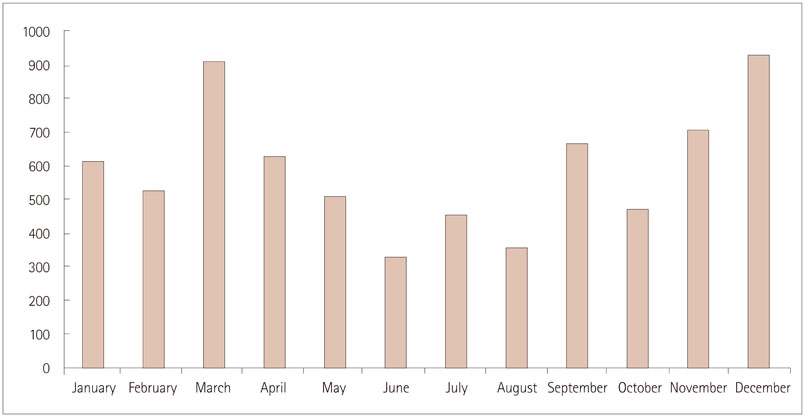J Clin Neurol.
2016 Oct;12(4):403-406. 10.3988/jcn.2016.12.4.403.
Seasonal Changes in the Incidence of Transient Global Amnesia
- Affiliations
-
- 1Department of Neurology, Rabin Medical Center, Petach Tikva, Israel. ophirkeret@gmail.com
- 2Statistical Consulting Unit, Beilinson Hospital, Rabin Medical Center, Petach Tikva, Israel.
- KMID: 2385102
- DOI: http://doi.org/10.3988/jcn.2016.12.4.403
Abstract
- BACKGROUND AND PURPOSE
Transient global amnesia (TGA) is a stereotypic condition characterized by anterograde and retrograde amnesia that typically resolves within 24 hours. The pathophysiology of TGA is still unclear. We noted that patients hospitalized with TGA tend to appear in seasonal clusters, and decided to investigate this phenomenon.
METHODS
Every patient with acute presentation of amnesia at our medical center is hospitalized for observation and evaluation. We reviewed the monthly occurrence of TGA in our patient population between 2000 and 2014, and compared this to non-TGA hospitalizations during the same time period.
RESULTS
During the analysis period, 154 patients who met the criteria for TGA were hospitalized, as well as 259,007 non-TGA hospitalizations. The annual occurrence of TGA ranged from 5 to 16 hospitalizations. There were 91 TGA events in women and 63 in men, in subjects aged 62.8±10.6 years (mean±SD). The incidence was maximal during December [odds ratio (OR)=2.83, 95% confidence interval (CI)=1.20-6.67] and March (OR=2.77, 95% CI=1.17-6.56), and minimal from April to August. The incidence exhibited an increase followed by a decrease from October to February. A seasonal trend was observed as well, with incidence peaks occurring in winter (OR=1.82, 95% CI=1.12-2.96) and spring (OR=1.80, 95% CI=1.10-2.94).
CONCLUSIONS
Our findings suggest that the incidence of TGA exhibits seasonal variations. This observation may help to improve the understanding of the pathophysiology underlying TGA.
Keyword
MeSH Terms
Figure
Cited by 1 articles
-
Seasonal Variation in the Incidence of Transient Global Amnesia in South Korea
SangHak Yi, Young Ho Park, SangYun Kim
J Clin Neurol. 2017;13(4):435-436. doi: 10.3988/jcn.2017.13.4.435.
Reference
-
1. Hunter G. Transient global amnesia. Neurol Clin. 2011; 29:1045–1054.
Article2. Bartsch T, Deuschl G. Transient global amnesia: functional anatomy and clinical implications. Lancet Neurol. 2010; 9:205–214.
Article3. Noël A, Quinette P, Dayan J, Guillery-Girard B, Piolino P, Pélerin A, et al. Influence of patients' emotional state on the recovery processes after a transient global amnesia. Cortex. 2011; 47:981–991.
Article4. Bartsch T, Alfke K, Stingele R, Rohr A, Freitag-Wolf S, Jansen O, et al. Selective affection of hippocampal CA-1 neurons in patients with transient global amnesia without long-term sequelae. Brain. 2006; 129:2874–2884.
Article5. Koski KJ, Marttila RJ. Transient global amnesia: incidence in an urban population. Acta Neurol Scand. 1990; 81:358–360.
Article6. Lewis SL. Aetiology of transient global amnesia. Lancet. 1998; 352:397–399.
Article7. Zorzon M, Antonutti L, Masè G, Biasutti E, Vitrani B, Cazzato G. Transient global amnesia and transient ischemic attack. Natural history, vascular risk factors, and associated conditions. Stroke. 1995; 26:1536–1542.
Article8. Jang JW, Park SY, Hong JH, Park YH, Kim JE, Kim S. Different risk factor profiles between transient global amnesia and transient ischemic attack: a large case-control study. Eur Neurol. 2014; 71:19–24.
Article9. Akkawi NM, Agosti C, Rozzini L, Anzola GP, Padovani A. Transient global amnesia and venous flow patterns. Lancet. 2001; 357:639.
Article10. Sander D, Winbeck K, Etgen T, Knapp R, Klingelhöfer J, Conrad B. Disturbance of venous flow patterns in patients with transient global amnesia. Lancet. 2000; 356:1982–1984.
Article11. Schmidtke K, Ehmsen L. Transient global amnesia and migraine. A case control study. Eur Neurol. 1998; 40:9–14.12. Tong DC, Grossman M. What causes transient global amnesia? New insights from DWI. Neurology. 2004; 62:2154–2155.
Article13. Hodges JR, Warlow CP. Syndromes of transient amnesia: towards a classification. A study of 153 cases. J Neurol Neurosurg Psychiatry. 1990; 53:834–843.
Article14. Christiansen CF, Pedersen L, Sørensen HT, Rothman KJ. Methods to assess seasonal effects in epidemiological studies of infectious diseases--exemplified by application to the occurrence of meningococcal disease. Clin Microbiol Infect. 2012; 18:963–969.
Article15. Fares A. Winter cardiovascular diseases phenomenon. N Am J Med Sci. 2013; 5:266–279.
Article16. Radke KJ, Izzo JL Jr. Seasonal variation in haemodynamics and blood pressure-regulating hormones. J Hum Hypertens. 2010; 24:410–416.
Article17. Stout RW, Crawford V. Seasonal variations in fibrinogen concentrations among elderly people. Lancet. 1991; 338:9–13.
Article18. Shahar DR, Froom P, Harari G, Yerushalmi N, Lubin F, Kristal-Boneh E. Changes in dietary intake account for seasonal changes in cardiovascular disease risk factors. Eur J Clin Nutr. 1999; 53:395–400.
Article19. Lopez J, Lomen-Hoerth C, Deutsch GK, Kerchner GA, Koshy A. Influenza-associated global amnesia and hippocampal imaging abnormality. Neurocase. 2014; 20:446–451.
Article20. Fisman D. Seasonality of viral infections: mechanisms and unknowns. Clin Microbiol Infect. 2012; 18:946–954.
Article21. Rösler A, Mras GJ, Frese A, Albert I, Schnorpfeil F. Precipitating factors of transient global amnesia. J Neurol. 1999; 246:53–54.
Article22. Bruijning-Verhagen P, Quach C, Bonten M. Nosocomial rotavirus infections: a meta-analysis. Pediatrics. 2012; 129:e1011–e1019.
Article23. Akkawi NM, Agosti C, Grassi M, Borroni B, Pezzini A, Vignolo LA, et al. Weather conditions and transient global amnesia. A six-year study. J Neurol. 2006; 253:194–198.
- Full Text Links
- Actions
-
Cited
- CITED
-
- Close
- Share
- Similar articles
-
- Seasonal Variation in the Incidence of Transient Global Amnesia in South Korea
- Transient Global Amnesia after Gastroscopy
- Recurrent transient amnesia: a case of transient epileptic amnesia misdiag-nosed as transient global amnesia
- Transient Global Amnesia Developed after Zolpidem Intake
- Retrograde Amnesia as a Predominant Symptom of Transient Global Amnesia



